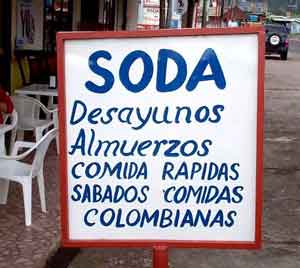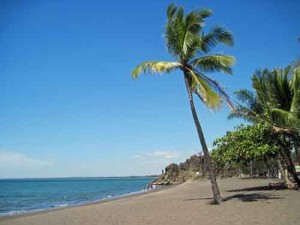Life in CR, Cost of Living
Why the Higher Cost of Living in Costa Rica Is Worth It
- By in Blog
by Tammy (Originally published by Viva Tropical. Used with permission.) Photos, links, and notes by RFLCR & updated on June 8, 2016.
 Costa Rica has been an increasingly popular destination among tourists and expats for several decades. And, while it stands out heads above the rest for its abundance of untamed nature and the healthy lifestyle it offers, cost of living in Costa Rica is not among its biggest selling points.
Costa Rica has been an increasingly popular destination among tourists and expats for several decades. And, while it stands out heads above the rest for its abundance of untamed nature and the healthy lifestyle it offers, cost of living in Costa Rica is not among its biggest selling points.
While still considerably cheaper than the cost to live a vacation-worthy lifestyle in a comparable North American city (as if there were any that could hold a candle to Costa Rica), the cost of living in Costa Rica is actually among the highest in Latin America. It’s also THE highest in Central America. Yet the number of tourists it draws each year and the hordes of expats who’ve chosen to call it home have hardly dwindled despite the rising costs.
Let’s dig a little bit deeper into what’s really driving the cost of living in Costa Rica and why so many North Americans still think it’s totally worth it.
So, just how much higher is the cost of living in Costa Rica?
Like any other factor, the cost of living in Costa Rica can vary drastically from one area to the next. It also depends entirely on your lifestyle. Live in some relatively unknown place that’s off the beaten path with few amenities and poor  infrastructure and you can get by on $1500 or less per month for a family of two. On the other hand, if you decide to make your home in a newly renovated high-rise condo in the Central Valley where you dine out every night and shop to your heart’s content, you could easily need double or even triple that amount of money to live. But let’s talk in generalities for a moment. The Economist publishes a study called The Big Mac Index, named for McDonald’s large greasy burger. It compares the purchasing power of different currencies by comparing the cost of like items (i.e. the Big Mac) among countries to see how over- or under-valued their money is. In January 2014, the average price of a U.S. Big Mac was $4.62. In Costa Rica it was $4.28. To reference a few other Latin American nations, Mexico was $2.78, Colombia $4.34, Peru $3.56, and Venezuela a whopping $7.15. (No other Central American countries made the study.)
infrastructure and you can get by on $1500 or less per month for a family of two. On the other hand, if you decide to make your home in a newly renovated high-rise condo in the Central Valley where you dine out every night and shop to your heart’s content, you could easily need double or even triple that amount of money to live. But let’s talk in generalities for a moment. The Economist publishes a study called The Big Mac Index, named for McDonald’s large greasy burger. It compares the purchasing power of different currencies by comparing the cost of like items (i.e. the Big Mac) among countries to see how over- or under-valued their money is. In January 2014, the average price of a U.S. Big Mac was $4.62. In Costa Rica it was $4.28. To reference a few other Latin American nations, Mexico was $2.78, Colombia $4.34, Peru $3.56, and Venezuela a whopping $7.15. (No other Central American countries made the study.)
Not everything is more expensive in Costa Rica.
While this index gives a decent baseline for comparing prices, it’s far from being the definitive word on the cost of living in third-world countries. Sure, a Big Mac might rival U.S. prices, but there are a number of things that still cost considerably less in Costa Rica.
 For example, due to the inexpensive cost of labor, many services can be had for a very reasonable price tag. Domestic help, like a maid or cook, can start as low as $3 per hour. A haircut will only set you back $3 or $4. Even the labor for auto repairs comes at an inexpensive rate. It’s the parts that will set you back a pretty penny. Education in Costa Rica is affordable as is the country’s health care (even at private facilities), which is of the highest quality. Property taxes are also low.
For example, due to the inexpensive cost of labor, many services can be had for a very reasonable price tag. Domestic help, like a maid or cook, can start as low as $3 per hour. A haircut will only set you back $3 or $4. Even the labor for auto repairs comes at an inexpensive rate. It’s the parts that will set you back a pretty penny. Education in Costa Rica is affordable as is the country’s health care (even at private facilities), which is of the highest quality. Property taxes are also low.
There are also a number of things that generally run about the same as their North American counterparts. Expenses in this category include utilities and services such as internet, cable, cell phone plans, water, and electricity. You can expect to pay about the same for these as you would in the U.S. although, depending on your location,you may have no need for heating and/or air conditioning expenses. Housing is also relatively inexpensive, with nice-size well-appointed accommodations ranging from $500 to $1500 per month.
However, as with all the above, it’s important to consider what you’re comparing these costs to. While much less on average than in the U.S., Canada, or Europe, individual budget items in Costa Rica can run significantly higher than in the rest of Central America.
What are Costa Rica’s big budget busters?
To answer this question, it’s important to consider a few important factors about the country. First of all, Costa Rica is a small country that must import a large number of the items people use for daily living. Add up the cost to get the items brought over plus the hefty import taxes the government loves to tack on, and things like automobiles and appliances can become incredibly expensive. On a smaller scale, the same is true for everyday items like imported wines or brand name peanut butter. So, to save considerably on your household expenditures, avoid anything imported. The country’s r elatively high utility costs are another big contributor to the higher cost of living in Costa Rica. They’re due to the monopoly held by government-run ICE (Instituto Costarricense de Electricidad, or the Costa Rican Institute of Electricity). Phone charges are based on usage, so you’ll pay depending on the amount of talking you do. Any vehicles brought into the country carry an extremely high import tax. Car tags are quite pricey as well. Gas in Costa Rica is also expensive, generally $1 to $2 more per gallon than in the U.S., which adds even more to the cost of owning a vehicle in Costa Rica. The poor driving conditions on Costa Rica’s subpar roads create additional wear and tear on vehicles, which creates the need for frequent mechanical work. In short, if you’re budget-conscious, don’t try to own a vehicle in Costa Rica. Public transportation is a much more affordable option.
elatively high utility costs are another big contributor to the higher cost of living in Costa Rica. They’re due to the monopoly held by government-run ICE (Instituto Costarricense de Electricidad, or the Costa Rican Institute of Electricity). Phone charges are based on usage, so you’ll pay depending on the amount of talking you do. Any vehicles brought into the country carry an extremely high import tax. Car tags are quite pricey as well. Gas in Costa Rica is also expensive, generally $1 to $2 more per gallon than in the U.S., which adds even more to the cost of owning a vehicle in Costa Rica. The poor driving conditions on Costa Rica’s subpar roads create additional wear and tear on vehicles, which creates the need for frequent mechanical work. In short, if you’re budget-conscious, don’t try to own a vehicle in Costa Rica. Public transportation is a much more affordable option.
What about food costs in Costa Rica?
This category also varies quite a bit depending on what and where you eat. Dining out, as evidenced by the Big Mac study,  can get expensive fast. That is, unless you dine at “sodas,” which are small, locally-run eating establishments. You can eat at local restaurants for $2 to $4 per person instead of the $15 to $20 you could expect to pay for a nice restaurant or chain franchise.
can get expensive fast. That is, unless you dine at “sodas,” which are small, locally-run eating establishments. You can eat at local restaurants for $2 to $4 per person instead of the $15 to $20 you could expect to pay for a nice restaurant or chain franchise.
If you like to cook, your best bet is to shop at local markets or do business with street vendors. You can choose from a great variety of locally-grown produce, beans, rice, and meat for a fraction of what you’d pay at the big box supermarkets, which closely resemble and even trace their roots back to some well-known U.S. chains. At the local street fairs you can buy big bunches of bananas for $.40 and large pineapples for only $1. You can also get freshly baked bread much cheaper (around $1.25 for a large loaf) from the local bakeries. On average, you can save about 30% on your grocery bill by avoiding the supermarkets. {RFLCR NOTE: that’s about what we save on our grocery bill.) You might expect great deals on fish and other seafood, but even these can get a little pricey, especially the further you get from the coast. Your best bet here is to make the occasional trip to the coastal areas to stock up at lower prices.
Why pay more to live in Costa Rica?
 That’s an easy question to answer. And, no, we’re not going to say that you get what you pay for. Although you do. The fact is that putting the cost of living in Costa Rica up against other Central American countries is hardly an apples to apples comparison. Sure you can find cheaper places to live, some even awfully close by. But Costa Rica offers so much more.
That’s an easy question to answer. And, no, we’re not going to say that you get what you pay for. Although you do. The fact is that putting the cost of living in Costa Rica up against other Central American countries is hardly an apples to apples comparison. Sure you can find cheaper places to live, some even awfully close by. But Costa Rica offers so much more.
In Costa Rica, you get a well-educated strong middle class population who are friendly and welcoming to outsiders. You get low crime and political stability. And, dare we forget to mention, you get one of the most amazingly beautiful settings on the entire planet. Most importantly, though, you get choices. With so many options available, in terms of housing, consumer goods, and services and amenities, you can pick and choose what’s important to you in Costa Rica. If you want to live, eat, and dress like a local so you can save up most of your dollars for travel throughout the region, you can totally do that. If you’d rather live like a king in the big city so that you never have any desire to go anywhere else, then that’s also an option.
So if this top expat destination is on your short list of countries you’re considering, don’t let the marginally higher cost of living in Costa Rica dissuade you.
Related Articles:
- The Economist’s Big Mac Index
- Paul’s Monthly Tip to Live for Less in Costa Rica: Hair Today, Gone Tomorrow
- Paul’s Monthly Tip to Live for Less in Costa Rica: Save on Car Repairs
- Paul’s Monthly Tip to Live for Less in Costa Rica: Save Thousands on Private Medical Care
- Paul’s Monthly Tip to Live for Less in Costa Rica: Save on Telephone Service
- Paul’s Monthly Tip to Live for Less in Costa Rica: Live Where You Don’t Need Heat or Air-Conditioning
- Paul’s Monthly Tip to Live for Less in Costa Rica: $1 Lunch at the Central Market
- Paul’s Monthly Tip to Live for Less in Costa Rica: Buy Local
- Paul’s Monthly Tip to Live for Less in Costa Rica: Eat Less Meat and More Fruits and Vegetables
- Another Reason We Chose Costa Rica – the People
